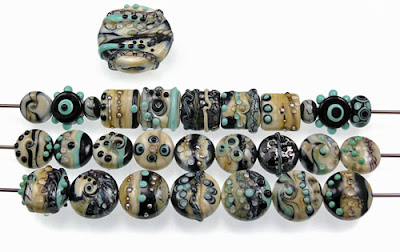New Lampwork Beads...Rant on Glass Compatiblity


Here's a couple of pictures of beads...I bet you figured that out by now. :-) I just got these done, cleaned, and photographed yesterday. I've got a bunch of new presses that I'm currently testing, I'm very pleased about the results. I'll have pictures latter.
I've been working on a custom that has been totally frustrating me. It's actually a simple one, one I was kinda excited to make (there are a lot of customs that I've done before that I've dreaded). I can't get the colors to blend well on this one. .I guess I have a mind's eye picture and that is what I want to create. That might be one of the issues.
The other problem is the glass it self...even if the glass is the same "104" COE, they still aren't compatible. Sure they look good when you pull them from the kiln...then wait 24 hours, cracks or crazing starts appearing. I've done encasements and then found a bead from that torch session I liked so I made a pendant. A couple weeks later, it cracked up the side. (it wasn't thermal shock nor the annealing process because I could duplicate the issue) It doesn't happen a lot but after several years of keeping notes, I've got a good idea of what not to put together...but that doesn't tell me about all the new glass that I currently coming out.
That leads to another issue when using 104 COE glass. Most of the glass manufacturers have all the basics...then each have some interesting colors...but they don't have all the kewl colors. I have to go from manufacturer to manufacturer to get the color palette that I want. I've got a huge box of test beads that are hung on cords, labeled with the date, color numbers and manufacturer. When I get new glass in, the first thing I do is test it with some of the more quirky glasses like Lauscha Cocco and Olive or some of the Italian corals and reds. BTW, not all Lauscha is 104...it ranges from 102 to 106.
Why do the same type of glasses can't be mixed together? Well it's more than the COE of the glass. (BTW COE means "coefficient of expansion", just for reference.) Just using COEs is not an accurate measure of compatibility. Glass also has viscosity characteristics which are as important as expansion characteristics. Both of these two properties will determine whether one glass will melt together well and stay together in the years to come.
Expansion is what affects the compatibility during the full temperature range (from cane to liquid to annealing point to room temperature). Where as viscosity has to do with surface tension during the cooling phase. I could go on a bit further with this but I get most folks won't read this far. :-)
Here's my rule of thumb that I use:
"Suppose you are aiming a torch at the end of a glass rod. When the glass gets hot enough, a molten drop will fall off the end. If the glass has low surface tension, the drop will be smaller; with high surface tension, the drop will be larger.If the glass has low viscosity, the drop will liquefy and fall very suddenly. If high viscosity, it can stretch out gradually before falling.The suddenness and size of the dripping are separately variable if you have arbitrary control of the composition of the glass."
If you are interested in reading up on glass...here's an URL that I would recommend:
Ok...I've got to get a few things done before I can zip off to the studio.
Have a happy, creative day,
~Moon